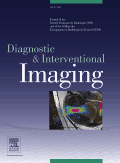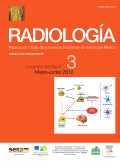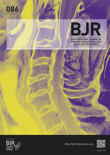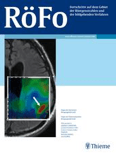
Diagnostic and Interventional Imaging
Scope & Guideline
Advancing the Frontiers of Imaging Excellence
Introduction
Aims and Scopes
- Advanced Imaging Techniques:
The journal prioritizes research on cutting-edge imaging modalities, such as spectral photon-counting CT, 4D flow MRI, and artificial intelligence applications in imaging, aimed at improving diagnostic capabilities. - Interventional Radiology:
It covers a wide range of interventional techniques, including cryoablation, embolization procedures, and minimally invasive treatments for various conditions, emphasizing their efficacy and safety. - Radiomics and AI Integration:
The journal explores the integration of radiomics and artificial intelligence in imaging, focusing on their potential to enhance diagnostic precision and prognostic capabilities in oncology and other fields. - Clinical Applications and Outcomes:
Research published often emphasizes the clinical relevance of imaging findings, aiming to correlate imaging techniques with patient outcomes, thereby bridging the gap between imaging and clinical practice. - Educational Perspectives:
It also addresses education in radiology, discussing best practices, challenges, and innovations in training programs for radiologists and interventional radiologists.
Trending and Emerging
- Artificial Intelligence in Radiology:
There is a growing emphasis on the application of artificial intelligence for image analysis and interpretation, enhancing diagnostic accuracy and efficiency in radiological practices. - Advanced Interventional Techniques:
Research on novel interventional radiology techniques, such as robotic-assisted procedures and advanced imaging-guided ablation therapies, is on the rise, reflecting innovations in minimally invasive treatments. - Multimodal Imaging Approaches:
The integration of various imaging modalities to improve diagnostic accuracy and treatment planning is gaining traction, particularly in oncology and complex cases. - Patient-Centric Imaging Research:
Emerging studies are increasingly focusing on patient outcomes and experiences related to imaging procedures, emphasizing the importance of patient-centered care in radiology. - Radiomics and Personalized Medicine:
There is a trend towards using radiomics for personalized medicine, where imaging features are analyzed to tailor treatments based on individual patient characteristics and disease profiles.
Declining or Waning
- Traditional Imaging Modalities:
There has been a noticeable decline in research focusing solely on traditional imaging modalities, such as standard X-rays and basic ultrasound applications, as the field increasingly emphasizes advanced and hybrid imaging techniques. - Basic Radiology Education:
Papers centered on foundational radiology education and basic imaging principles are becoming less frequent, as the focus shifts towards specialized training in advanced imaging and interventional procedures. - Non-Interventional Studies:
Research that does not involve interventional techniques or clinical decision-making based on imaging findings seems to be waning, reflecting a trend towards studies that directly impact patient management.
Similar Journals

RADIOLOGIA
Transforming patient care through pioneering imaging techniques.RADIOLOGIA is a distinguished journal in the field of Radiology, Nuclear Medicine, and Imaging, published by Elsevier España. With a rich history since its inception in 1961, this journal serves as a vital resource for professionals, researchers, and students interested in the latest developments and innovations in radiological practices. Although it is currently categorized in the Q3 quartile, its contributions continue to shape and advance clinical practices and research in radiology. RADIOLOGIA provides a platform for scholarly articles, reviews, and case studies that underpin the complexities of imaging techniques and nuclear medicine, while also addressing emerging trends and technologies. The journal is indexed with the ISSN 0033-8338 and E-ISSN 1578-178X, reflecting its accessibility to a global audience dedicated to enhancing patient care through advanced imaging methodologies. Readers can find the journal published in Spain and benefit from its commitment to disseminating pertinent research across diverse aspects of radiology.

BRITISH JOURNAL OF RADIOLOGY
Shaping the Future of Imaging through Rigorous ResearchBritish Journal of Radiology is a leading peer-reviewed journal published by the British Institute of Radiology, dedicated to advancing the field of radiology, nuclear medicine, and imaging. With a prestigious history dating back to 1945, this journal is at the forefront of disseminating cutting-edge research and innovations that significantly impact clinical practice. Currently enjoying a Q1 ranking in the field of radiology and Q2 in general medicine for 2023, it is recognized for its rigorous standards and high-quality content, ranking #87 out of 333 in Scopus for specialties related to Medicine, Radiology, Nuclear Medicine, and Imaging, placing it in the 74th percentile. Researchers, professionals, and students are encouraged to engage with the latest findings and comprehensive reviews presented within its pages, which contribute not only to academic discourse but also to the evolution of practice in the wider medical community.

European Radiology Experimental
Advancing Radiology Through Innovative ResearchEuropean Radiology Experimental is a premier open-access journal published by Springer Wien, dedicated to advancing the field of radiology through innovative research and experimentation. Since its establishment in 2017, the journal has quickly gained recognition, evidenced by its impressive Q1 ranking in the Radiology, Nuclear Medicine and Imaging category, and its placement within the top 83rd percentile of the Scopus rankings. Based in the United Kingdom, this journal aims to bridge the gap between clinical practice and cutting-edge research, providing a platform for rigorous peer-reviewed articles that explore new methodologies, technologies, and insights in radiological sciences. With a commitment to open access, European Radiology Experimental ensures that its content is readily accessible to a global audience, supporting the dissemination of knowledge and fostering collaborations among researchers, professionals, and students in the medical imaging community. As it progresses through its convergence years, the journal continues to play a vital role in shaping the future of radiological research and practice.

EUROPEAN JOURNAL OF RADIOLOGY
Bridging Research and Clinical Excellence in RadiologyThe European Journal of Radiology, published by Elsevier Ireland Ltd, is a premier peer-reviewed journal in the fields of radiology, nuclear medicine, and imaging. Established in 1981, it has carved a significant niche within the academic community, showcasing innovative research that enhances medical imaging practices and improves patient care. With an impressive ranking in the Q1 category for both Medicine (miscellaneous) and Radiology, Nuclear Medicine, and Imaging in 2023, the journal is recognized globally for its commitment to advancing scientific knowledge and improving imaging methodologies. The journal's Scopus ranking of #60/333, placing it in the 82nd percentile, underlines its reputation for high-quality research and scholarly contributions. While traditionally a subscription-based journal, it continually evolves to meet the demands of the academic landscape, aiming to bridge the gap between research and clinical practice. Researchers, healthcare professionals, and students alike can benefit from exploring its extensive archives and current publications, which are curated to foster education and innovation in the medical imaging domain.

ROFO-FORTSCHRITTE AUF DEM GEBIET DER RONTGENSTRAHLEN UND DER BILDGEBENDEN VERFAHREN
Illuminating Innovations in Imaging and TherapyROFO-Fortschritte auf dem Gebiet der Röntgenstrahlen und der bildgebenden Verfahren, published by Georg Thieme Verlag KG, is a pivotal journal in the fields of radiology and nuclear medicine, offering invaluable insights for researchers, healthcare professionals, and students alike. With an ISSN of 1438-9029, this journal has been a stalwart of scientific communication since its inception in 1975, actively contributing to advancements in imaging techniques and radiation therapy. Although it operates under traditional access, the journal maintains a respectable standing, reflected by its Q3 ranking in Radiology, Nuclear Medicine and Imaging and Q4 in Medicine (miscellaneous), highlighting its significance in the scholarly community. Its coverage spans a wide array of topics pertinent to diagnostic imaging and therapy protocols, making it an essential resource for anyone seeking to understand the complexities of modern radiological practices. As the journal continues to evolve through 2024, it invites contributions that enrich the dialogue around technological innovations and clinical applications in the realm of imaging modalities.

SEMINARS IN MUSCULOSKELETAL RADIOLOGY
Elevating Clinical Practices with Radiological InsightsSEMINARS IN MUSCULOSKELETAL RADIOLOGY is a leading journal in the fields of Orthopedics and Sports Medicine, as well as Radiology, with a strong emphasis on advancing the understanding and application of imaging techniques in musculoskeletal disorders. Published by THIEME MEDICAL PUBL INC, this esteemed journal boasts a reputation for high-quality, peer-reviewed articles that span essential topics ranging from diagnostic imaging methods to innovative therapeutic strategies. With its ISSN 1089-7860 and E-ISSN 1098-898X, the journal is a vital resource for researchers, clinicians, and students eager to stay updated on the latest developments in musculoskeletal imaging. Notably positioned in the Q3 category for both Orthopedics and Sports Medicine and Radiology, Nuclear Medicine and Imaging, it serves as an essential platform for sharing pioneering research and clinical practices that enhance patient care. Operating in a traditionally challenging landscape for publication access, its focus remains on rich, impactful content that resonates with the academic community, despite currently non-open access delivery. Since its inception in 1999, the journal has endured, adapting to the ever-evolving medical landscape and continues to contribute significantly to the scientific body of knowledge through 2024 and beyond.

Journal of the Belgian Society of Radiology
Fostering Collaborative Research in RadiologyThe Journal of the Belgian Society of Radiology, published by UBIQUITY PRESS LTD, is a pivotal resource in the field of radiology, nuclear medicine, and imaging. With an ISSN of 2514-8281 and E-ISSN of 2514-8281, this open access journal has been dedicated to fostering the dissemination of high-quality research since its establishment in 2010. Distributed from the United Kingdom, it offers a platform for innovative studies, case reports, and reviews that contribute to the advancement of radiological sciences. Despite its current Q4 category ranking within Scopus, the journal plays a critical role in sharing essential findings with a community of over 1,200 professionals and students eager to stay abreast of emerging trends and technological advancements in imaging. By enabling unrestricted access to its publications, the journal encourages collaborative research and knowledge exchange that transcends geographic boundaries, solidifying its importance for both established researchers and emerging scholars in the discipline.

Radiologia Medica
Unveiling the Future of Medical Imaging Techniques.Radiologia Medica, published by Springer-Verlag Italia SRL, is a premier Italian journal dedicated to the field of radiology, nuclear medicine, and imaging. With a rich history dating back to 1947, this journal has consistently provided cutting-edge research and findings, contributing significantly to advancements in medical imaging techniques and practices. As evidenced by its impressive Q1 rankings in both Medicine (Miscellaneous) and Radiology, Nuclear Medicine and Imaging, Radiologia Medica holds a prestigious position within the top tier of medical journals, ranked #11 out of 333 in its category and residing in the 96th percentile according to Scopus metrics. Although it is not currently offered as an Open Access journal, its robust subscription model supports extensive research dissemination. Researchers, professionals, and students alike will find invaluable insights and knowledge critical for advancing their understanding and practice within this dynamic field. Situated in Milan, Italy, Radiologia Medica continues to be an influential platform for the exchange of high-quality research, bridging various disciplines and promoting excellence in radiological science.

RADIOLOGY
Exploring new horizons in diagnostic imaging.RADIOLOGY, published by the Radiological Society of North America (RSNA), stands as a premier journal in the fields of radiology, nuclear medicine, and imaging. Established in 1945, this esteemed journal has consistently provided groundbreaking research and insights, helping to shape advancements in diagnostic imaging and therapeutic interventions. With a commendable Q1 ranking in its category and a remarkable 99th percentile ranking in Scopus, RADIOLOGY continues to be a pivotal resource for clinicians, researchers, and students alike. Although not an Open Access journal, it offers a wealth of high-quality peer-reviewed articles that contribute significantly to the ongoing discourse in the medical community. With a strong focus on innovative techniques and the integration of new technologies, RADIOLOGY remains essential for professionals aiming to stay at the forefront of medical imaging practices.

Insights into Imaging
Transforming Research into Clinical ExcellenceInsights into Imaging is a prominent open-access journal published by SPRINGER WIEN, specializing in the dynamic fields of radiology, nuclear medicine, and imaging, with its ISSN 1869-4101. Established in 2012, the journal has established itself as a leading platform for disseminating high-quality research and innovative findings, currently holding a prestigious Q1 ranking in its category as of 2023. With an impressive Scopus rank of #42 out of 333 in the medicine discipline, the journal is positioned in the 87th percentile, reflecting its significance and influence in the academic community. Based in Germany, Insights into Imaging not only provides unrestricted access to research but also aims to bridge the gap between scientific inquiry and clinical application, making it an essential resource for researchers, professionals, and students engaged in advancing imaging technologies and practices. The journal’s commitment to fostering knowledge exchange ensures that it remains a critical contributor to the evolving landscape of medical imaging, with articles available from 2012 through 2024.